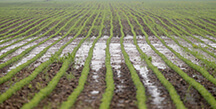Farmers face crunch time to replant flooded soybean fields
July 2, 2015
 |
|
Rows of young soybean plants in rain-soaked, saturated ground in Tippecanoe County. (Purdue Agricultural Communication photo/Tom Campbell) |
WEST LAFAYETTE, Ind. - With rainy conditions expected to continue across parts of the Midwest for the next week, northern Indiana soybean farmers will have to race against the clock to get in an initial crop or replant their flood-damaged fields, a Purdue Extension specialist says.
“We are quickly marching on the end of time to successfully plant soybeans for grain,” said Shaun Casteel. “It’s going to be extremely tight.”
Whether planting an initial crop or replanting flood-damaged fields, Casteel recommends using a shorter-season variety and planting at least 200,000 seeds per acre.
“If soybeans are to be planted for grain harvest, we need to shorten the maturity group by 1.0 unit relative to the full season in your area,” he said. “We will mature about 7 to 10 days faster with that shorter-season variety.”
High seeding rates are needed to “push the plants and first pods higher, produce more nodes on an area basis and canopy faster,” he said.
Farmers also need to determine the latest possible planting date for their area. Even shorter-season varieties need about 90 days to mature or be close enough to maturity for harvest.
“If the fall freeze is typically October 10, then soybeans need to be replanted and emerged by July 10 to have a chance at producing harvestable grain this fall,” he said. “Soil moisture and temperatures should allow soybeans to emerge quickly.
Casteel estimates that late planting could produce about 50 to 60 percent of a normal grain harvest.
According to the latest U.S. Department of Agriculture Crop Progress report, 96 percent of Indiana’s soybean crop had been planted as of June 28, compared with 98 percent the same time last year. The report showed only 49 percent of the state’s soybean crop rated as good to excellent, down from 58 percent a week earlier and 71 percent the week ending June 14.
Although time for initial planting or replanting soybeans is running short, farmers shouldn’t rush into saturated fields, Casteel cautioned. Heavy equipment could compact the wet soil or leave deep ruts, making next year’s planting season more difficult.
Casteel said farmers who were unable to get their soybean crops planted this year because of the wet conditions should still consider planting soybeans as a cover crop or look at alternative cover crops to preserve soil nutrients for next year.
“We should plant something in these fields and large drowned-out areas to help suppress weeds, take up moisture and nutrients and stabilize the soil for this year and next year,” he said.
There is no need to use a shorter-season variety if the soybeans are planted as a cover crop, he said, because the goal is to produce biomass and ground cover, not grain.
Casteel has published a guide to late planting of soybeans in the latest issue of Purdue’s Pest and Crop online newsletter. To read the full article, go to http://extension.entm.purdue.edu/pestcrop/2015/Issue14/.
Writer: Darrin Pack, 765-494-8415, dpack@purdue.edu
Source: Shaun Casteel, 765-494-0895, scasteel@purdue.edu
Ag Communications: (765) 494-2722;
Keith Robinson, robins89@purdue.edu
Agriculture News Page

